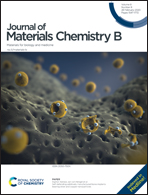Stimuli-responsive release and efficient siRNA delivery in non-small cell lung cancer by a poly(l-histidine)-based multifunctional nanoplatform
Abstract
Small interfering RNA (siRNA) has extensive potential for the treatment of non-small cell lung cancer (NSCLC). While both cationic lipids and polymers have demonstrated promise to facilitate siRNA encapsulation, they can also hamper cytosolic siRNA release and induce severe cytotoxicity. To address these issues, a unique polymer hybrid nanoparticle (NP) nanoplatform was developed for multistage siRNA delivery based on both pH-responsive and endo/lysosomal escape characteristics, which was formed via a combination of an electrostatic interactions between the copolymer methoxy poly(ethylene glycol)-poly(L-histidine)-poly(sulfadimethoxine) (mPEG-PHis-PSD, shortened to PHD), dendritic poly-L-lysine (PLL) and PLK1 siRNA (shortened to siPLK1). The biological composition of the proton sponge effect polymer of the PHis chain, which was in position to make efficient endo/lysosomal escape, and the pH-responsive polymer of the PSD fragment, which could accelerate the release of siPLK1. In the present study, the NP illustrated excellent physiochemical properties and rapid endo/lysosomal escape in vitro. Besides this, compared with the PD/PLL/siRNA formulation, the PHD/PLL/siRNA NP indicated higher cellular uptake, and higher cell cytotoxicity in vitro. The in vivo results demonstrated that the PHD/PLL/siRNA NP exhibited the strongest tumor growth inhibition rate and ideal safety compared with the control and other siPLK1-treated formulations, which can be mainly attributed to pH-induced instantaneous dissociation and efficient endo/lysosomal escape arising from the PHD copolymer. Consequently, the above evidence indicates that the PHD/PLL/siRNA NP is a favorable gene delivery system and provides a potential strategy for siRNA delivery.



 Please wait while we load your content...
Please wait while we load your content...